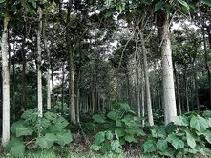| Renewable Energy Solutions |
 |
| HDSR Trees for High-yield Biomass for Non-food Biofuel grown on marginal land unsuitable for food crop |
|
|
 |
| Camelina non-food biofuel source grown on soil unsuitable for food, high-yield, 2 harvests/year... |
|
|
|
|
Non-Food, Second Generation Biofuel Energy Sources:
HDSR Trees and Camelina
For food security, fuel is required. The fossil fuel oil business is "antiquated, dirty, dangerous and corrupt," stated Josh Tickell, UN Goodwill Ambassador of Renewable Energy, author and filmmaker of FUEL. For the sake of the environment and humanity, sustainable, compassionate alternatives are urgently required. Two high-value agricultural opportunities for communities throughout the world. These involve:
- HDSR Trees - high-yield biomass
- Camelina - a sustainable oilseed crop
Evidence-based agricultural solutions are required to reduce our dependence on foreign oil and greenhouse gases; create green collar jobs; and address the world food crisis. Both Camelina and HDSR trees are the two evidence-based agricultural solutions that are addressing these needs and available now. They both:
1. Grow on marginal land, unsuitable for food crops, with low water and other input requirements.
2. Revive marginal, unused land by improving soil quality.
Complimentary Consultation
Learn more about both HDSR tree and Camelina through the overviews below. Then phone Deborah Dupre on (+1) 310.310.1997 for a complimentary consultation with her bio-energy associate who is happy to answer questions about these valuable opportunities to help ensure local, sustainable fuel production.
Soon, you, too can be farming these evidence-based, non-food, biofuel feedstocks that to reduce your community's and our planet's dependence on fossil fuel. You, too can be joining singer and renewable energy advocate, Neil Young in saying, "It's one of the most patriotic things I've ever done." (FUEL 2008.)
HDSR Tree Overview
A High-Density, Short-Rotation (HDSR) tree is a fast growing tree (up to 60 feet in 2-3 years) with high yield of cellulosic biomass per acre. One HDSR tree species was selected due to its variety of exceptionally valuable properties:
- High yields
- Regenerates from its own stump after harvest
- Tolerance of poor quality soil and irrigation water
This species' fast-growing, deep taproot can penetrate 40 feet or more, drawing nutrients, water, contaminants and heavy metals from subsoil to the surface feeding the plant. Its extensive mat-like lateral root system draws from upper soils in an area up to twice the size of the crown of the tree and 12-36 inches deep.
IMPORTANT NOTE: Some HDSR species are known to be highly invasive, making them unsuitable for biomass production. The species and varieties chosen for industry, however, do not produce viable fruit/seeds, rendering them virtually sterile. These trees have been widely used in lumber plantations where they have been demonstrated as completely non-invasive.
Due to its fast growth and aggressive rooting, over the past century, this tree has been extensively used to:
- Stabilize highly erodible land
- Phytoremediate contaminated land
Evidence-based
- Over 20 years, there has been intensive research and development related to the HDSR trees' ability to uptake nitrates, heavy metals, and land contaminants.
- University of Kentucky and University of Maryland published several papers on exceptional characteristics for mine site reclamation and soil stabilization.
Energy crop
- Various North American Universities have confirmed wood characteristics, growth properties and soil and climate preferences of this HDSR species.
- Genetically superior varieties we offer have been successfully proven viable energy crops, based on studies showing their effectiveness for producing Ethanol via Acid Hydrolysis, Thermochemical, Pyrolysis, and Gasification processes.
- This species provides high density of biomass per acre required for cellulosic biofuel production and other energy uses.
- This species can be grown on land not used for food production, eliminating the food versus fuel debate.
Renewable Energy Benefits:
- Regenerates from its stump after harvest so there is no need to replant
- Land and surrounding area are not devastated after harvest, making this tree a truly renewable resource
- Massive leaves absorb large quantities of airborne contaminants and sequester carbon, thereby emitting clean, naturally filtered oxygen to the atmosphere
- Perfect for reforestation
- Extensive root system stabilizes soil and remediates land
- Superior uptake of nitrates, heavy metals, contaminants and other elements from hallow and deep sub soils
- High conversion ratio of nutrients, carbon and other elements to wood fiber
- Excellent sequestration of carbon dioxide from the air
- Tolerates wide range of climatic and ecological conditions with low fire risk
Deborah Dupré AEPI's commitment to worldwide fossil fuel oil independence led it to its collaboration with the world leader in developing and producing the world's fastest growing biomass tree for an energy crop.
Truly sustainable
- Harvesting on an annual basis and then allowing the tree to re-grow from its own stump crates a truly sustainable biomass plantation.
- Once the trees are established, ongoing plantation maintenance is simple, including fertilization and irrigation (as needed, depending on natural rainfall and age of trees).
- Natural fertilizers (animal or human waste) can be used to decrease petroleum-based inputs to the plantation.
- High density of biomass produced per acre allows for many different uses for the biomass including local production of bio-power, biofuel, and other biochemical.
For more information about how you can become a HDSR plantation owner or investor, email info@ecopeaceinternational.com or phone (+1) 310.310.1997 for a free consultation.
Camelina Overview
Another important new player "fueling" the alternative energy market as fossil fuels continue falling short is Camelina:
- Is an oilseed crop in the Brassica family
- Is now grown throughout U.S. and Canada where the oilseed is crushed to produce biodiesel
- Over 10-million road miles have already been grown in U.S. with plans to boost this production to 100 million gallons by 2012.
- U.S. Energy Bill signed at end of 2007 increases Renewable Fuels Standard (RFS) to 36 billion gallons by 2022.
- Airline demonstration flights using Camelina biofuel, and subsequent flights confirm the Camelina 2nd-generation biofuel's operational performance capabilities and commercial viability.
Camelina provides sustainable, low-input, biofuel feedstock that does not interfere with food production.
Camelina Benefits:
- Virtually 100% efficient
- Harvested and crushed for oil while remaining parts can be used for high-quality, omega-3 rich animal feed
- Grows on marginal land, unsuitable for food crops and uses little moisture
- Is an excellent rotational crop to break cycle of continuous, small grain crops requiring excessive petrochemical based fertilizer
- Can enhance yield of subsequent crops such as wheat by up to 15%
- Aids in reduction of weed and disease cycles
- Camelina Biodiesel helps local economies, reduces need for foreign oil supplies on a national level, reduces gashouse emissions
Camelina's four significant advantages in the world of biofuel:
- Sustainability - Camelina is the only currently available biodiesel feedstock that is non-food, grows on marginal land, and requires little input, including water. (It is currently being grown in high plains desert with as little as 6-8" of annual rainfall.)
- Profitability - Provides high-quality oil for biodiesel production at a $0.o5/lb lower price than competing oil, while also compensating growers with a healthy return for their marginal land use. Equity investor return is in excess of 30% over 5 years.
- Scalability - 100 million gallons can be produced with only 1 million acres of Camelina production over the next 5 years; a very small percentage of suitable land available for production of the crop in the U.S., not to mention opportunities internationally.
- Flexibility - Makes an ideal oil for development of 2nd generation biofuel products including 'drop-in' transportation and aviation fuel.
Camelina is the only a 90-day crop that can be planted in the fall or spring, allowing the potential for double-cropping with other crops in summer months.
For more information on ways that you can become involved in this 2nd-generation biofuel opportunity and others, email info@ecopeaceinternational.com or phone our office on (+1)310.310.1997 to make an appointment for a complimentary consultation.

|
|
|
 |
| Camelina Fueling the Future |
|
|
|
 |
| FUEL Ventura! with Mom, Deborah Dupre' |
|
|
|
|